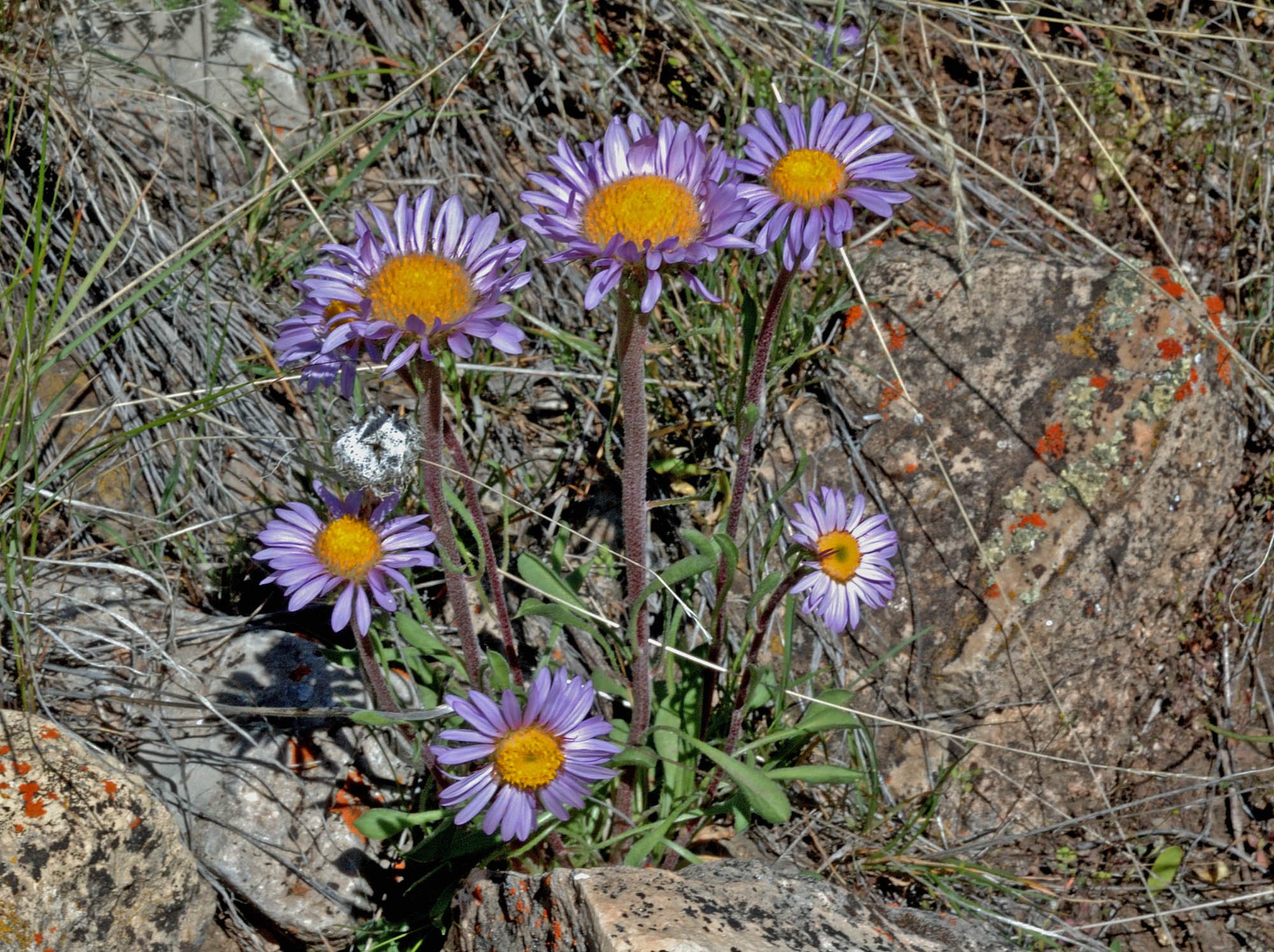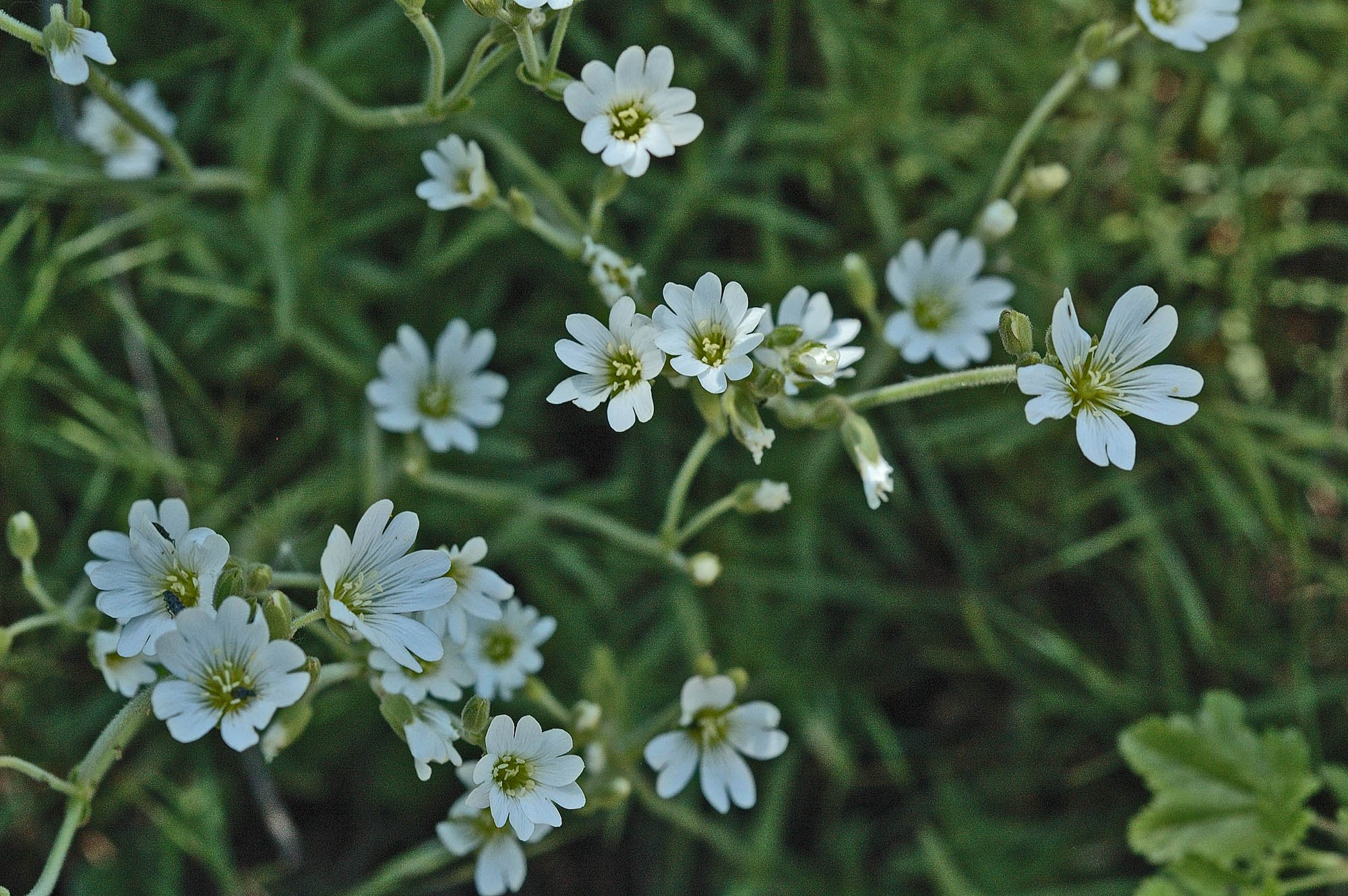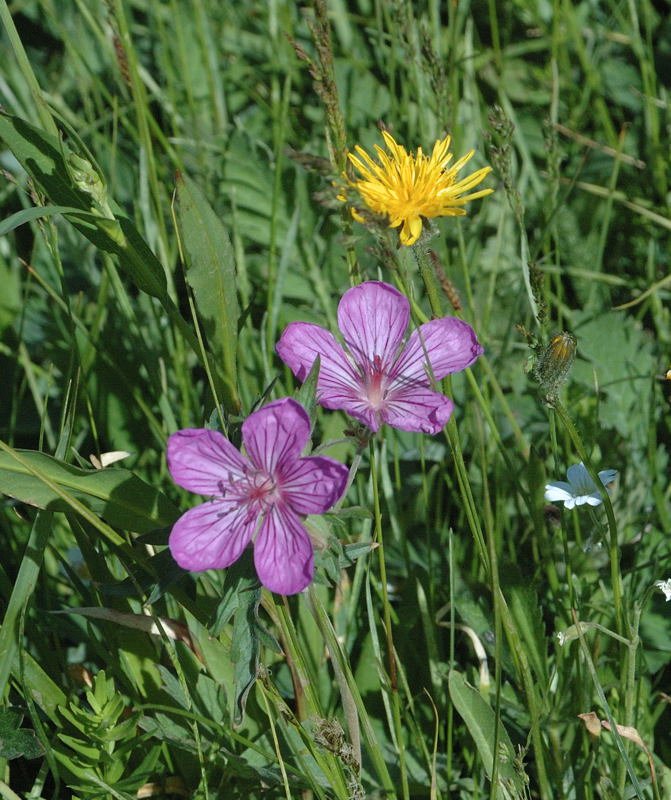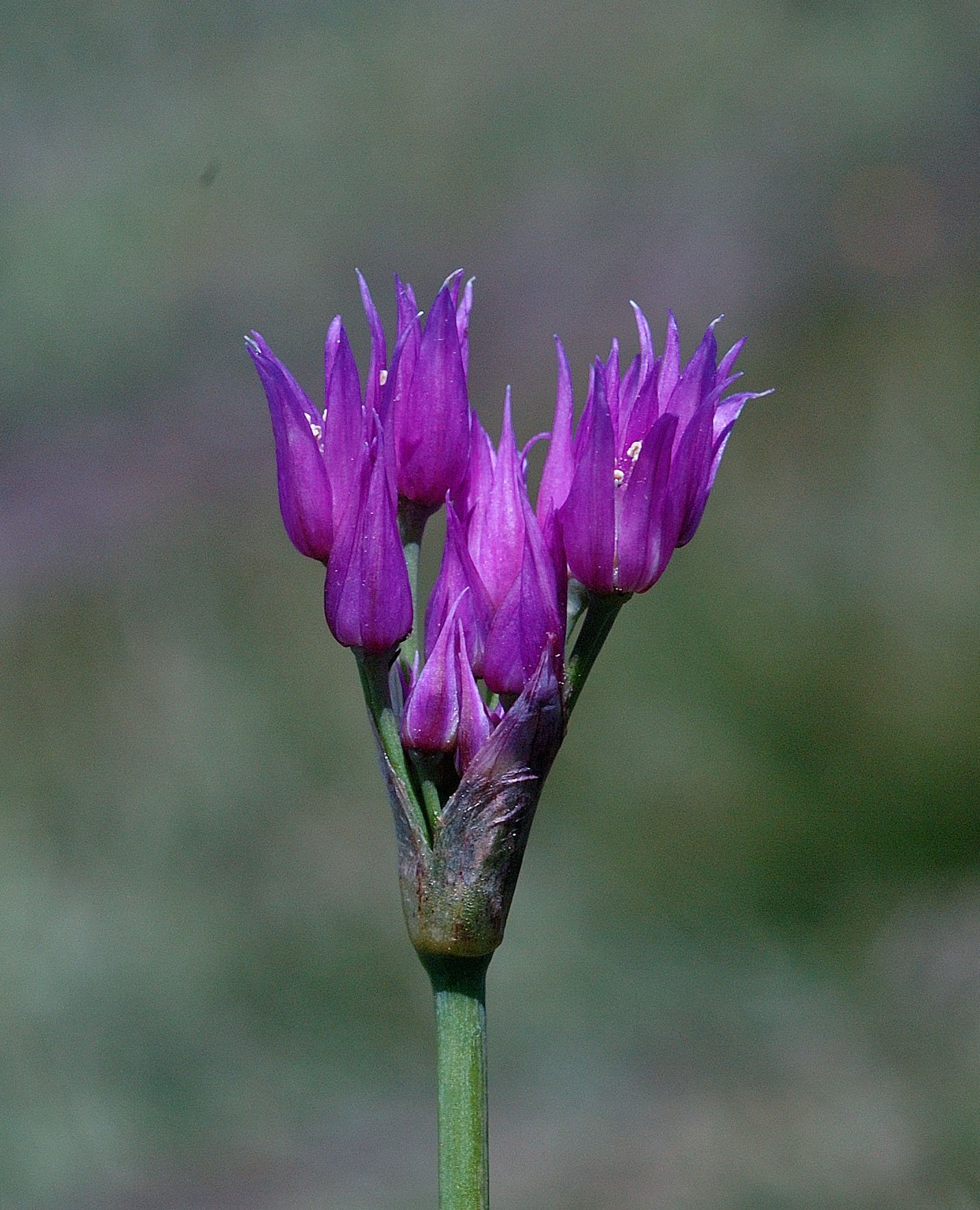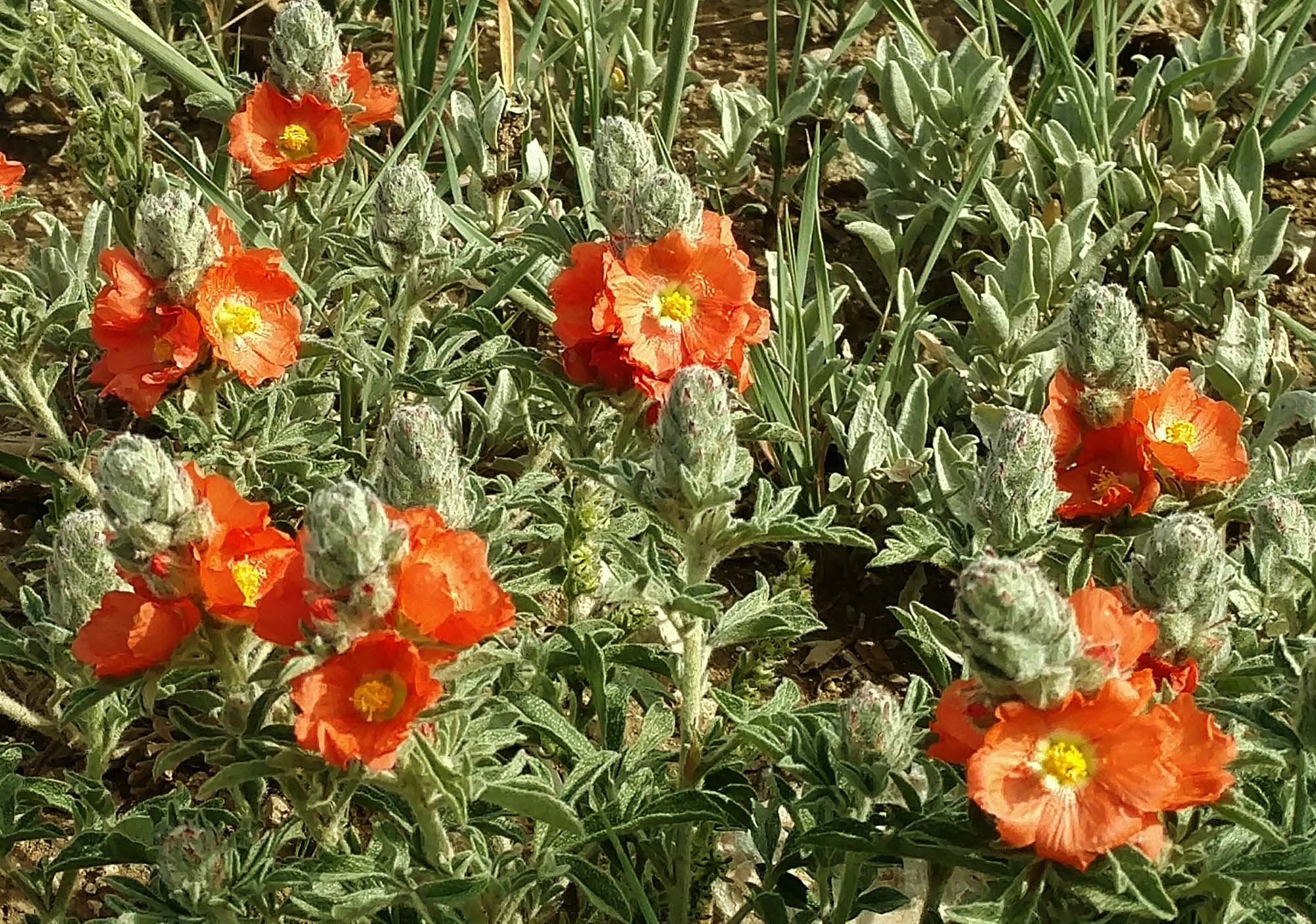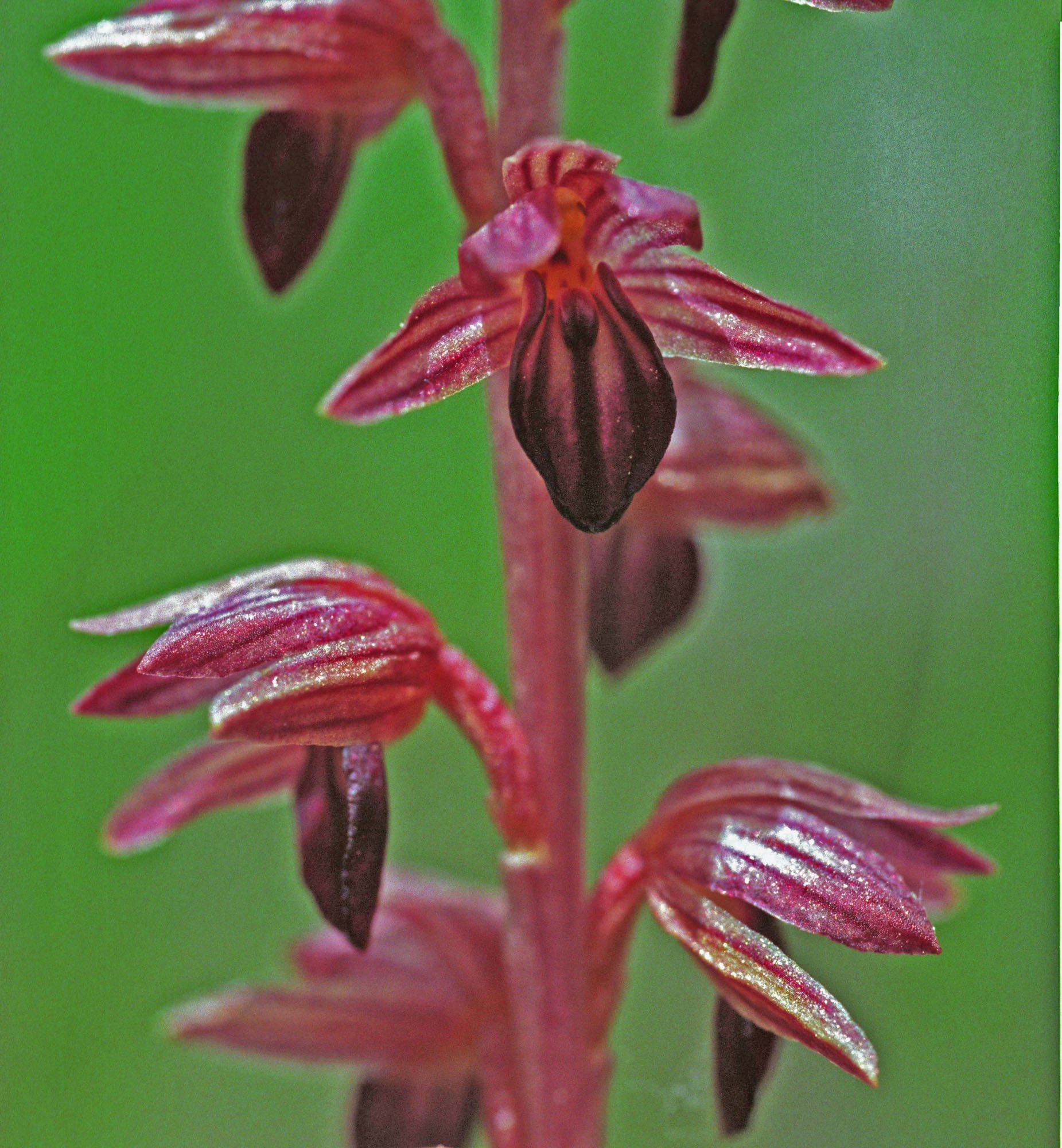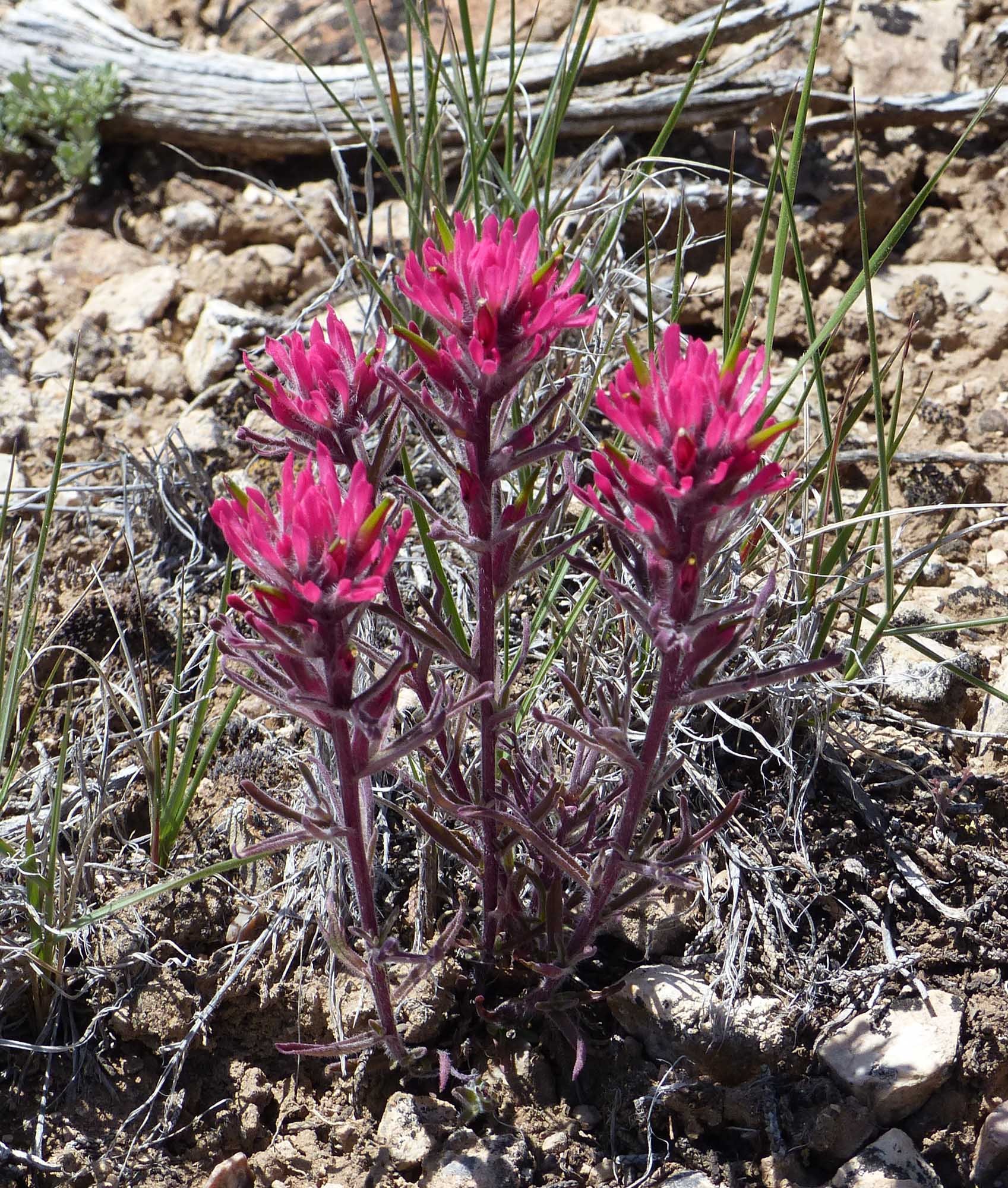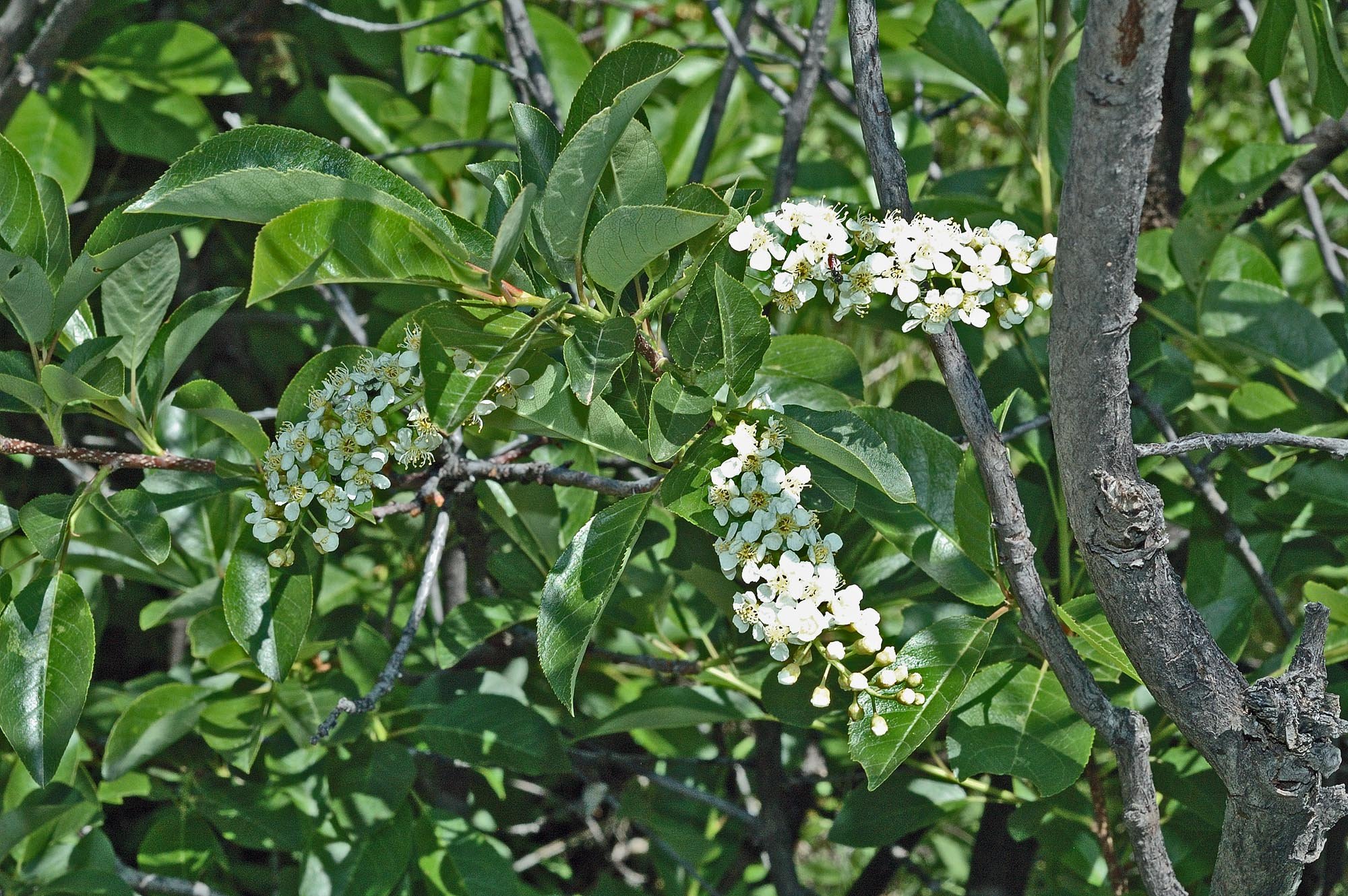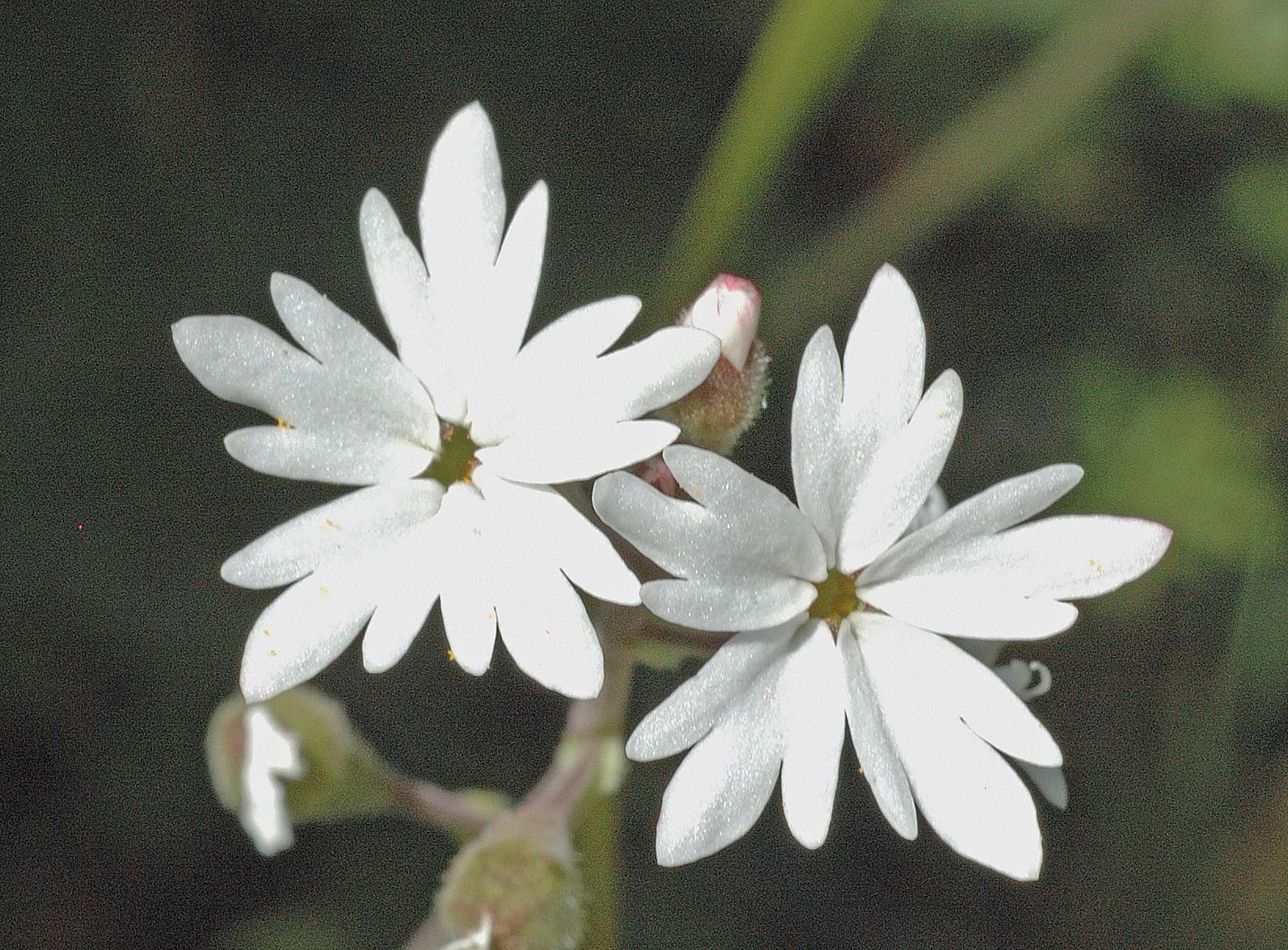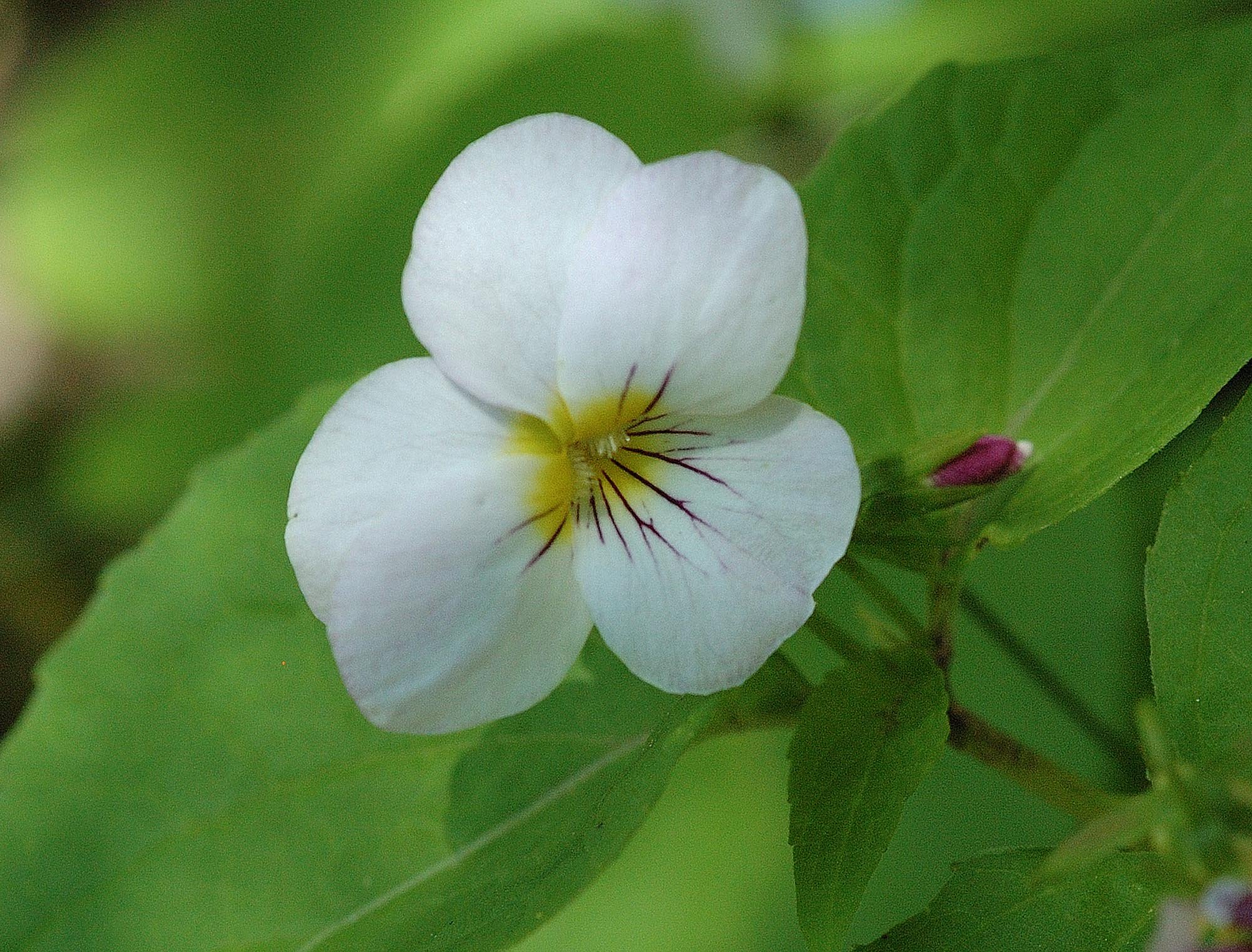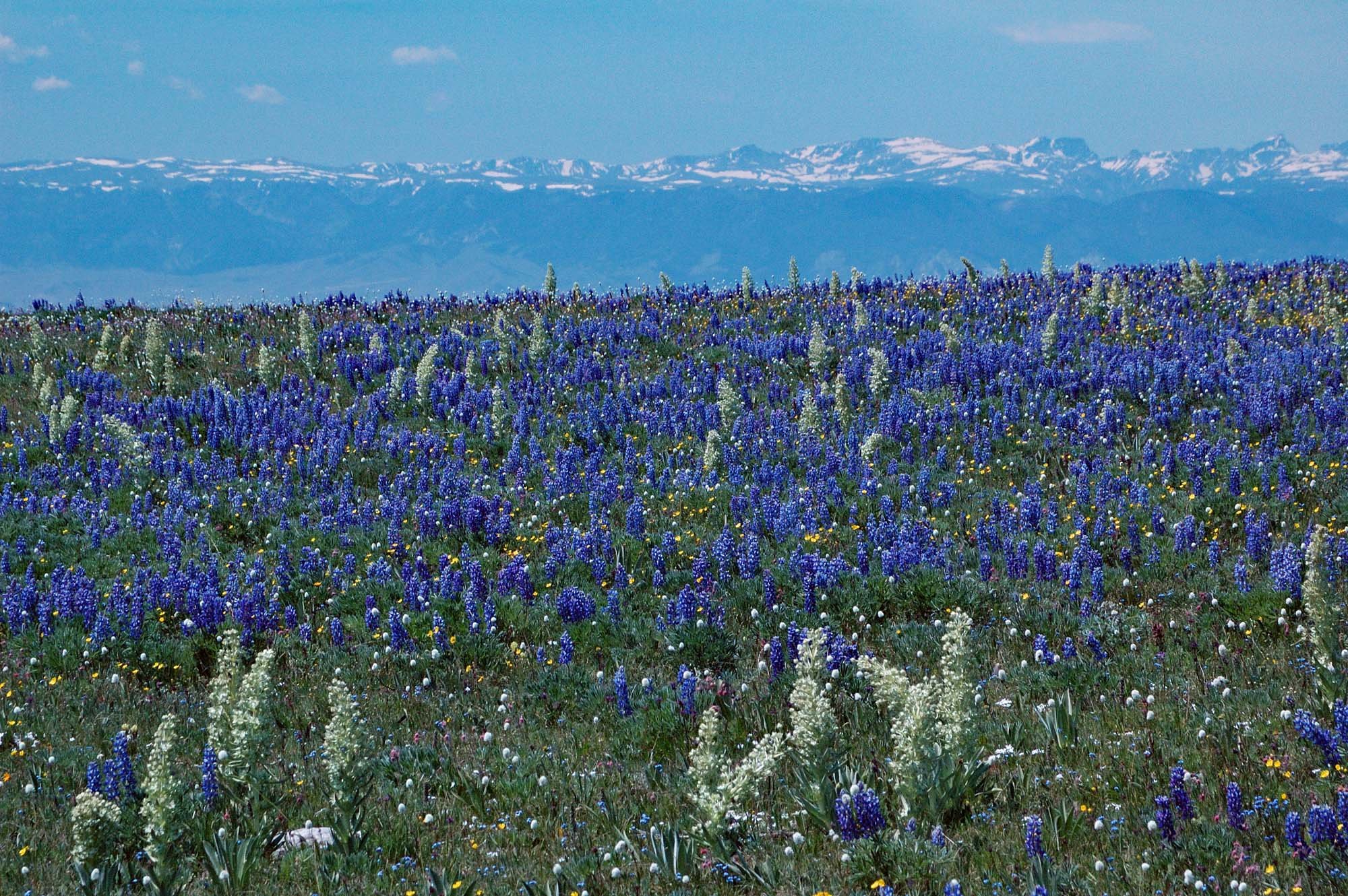
Wildflowers of the Pryors
Blue, yellow, purple, pink, gold, white, green, stripes, swirls, multicolors and hues beyond description....
The Pryor Mountains have rolling carpets of flowers, isolated pockets of floral jewels, meadows to dazzle the eye and a dyer’s vision of rainbow colors
Green Gention, Lupine, Bistort and more. Beartooth Mountains in the distance. (D. Walton photo)
Look for half-a-dozen wildflower species in this photo (dw)
See more than 100 photos of more than 70 wildflower species in the gallery below.
All photos were taken in the Pryors.
We have had help from botanists Peter Lesica and Jennifer Lyman on some of the species IDs. Any errors are ours.
There are flowers in the Pryor Mountains from early spring to late fall - blooming times vary with elevation and habitat. They range from purple Pasque Flowers, braving late snows, tiny pink five-petalled flowers of Kelseya, yellow Fritillaries and Spring Beauties (Claytonia) in the spring, to pink Bitterroot, blue lupines, red Striped Coralroot, purple Shooting Stars, dark blue larkspur, red and yellow paintbrushes of early summer. Explorer’s Gentian and Fawn/Glacier Lilies grow near snow melts and wet spots.
Elegant yucca with large creamy flowers stand here and there. Tiny white Prairie Starflowers twinkle in patches of mixed grasses. White, blue and purple penstemon sway in the mountain breeze. Carpets of phlox create islands of white in the green meadows while blue Forget-me-nots grow low to avoid the cold winds. Dusty pink Long Stemmed Avens nod in the shade and wild blue Iris stand by the road. Green gentians display green flowers. White Canada Violets revel in damp, shady spots. Asters such as Arrowleaf Balsamroot announce high summer. Golden Prince’s Plumes parade across the hillsides. Blue flax, yellow and red Gallardia (blanket flowers), and flowering cactus bedeck ridge and slope. A visual feast.
Where to Go for Pryor Mountain Flower Watching
Lupine and Arrowleaf Balsamroot on forest floor
Lupinus sp. and Balsamorhiza sagittata (cm)
A good first trip is along Pryor Mountain Road in the north Pryors. (directions and map) Once you enter the National Forest the road begins climbing steadily. Spring moves up in elevation during May, June and July. Just drive up until you see flowers. Stop at an open slope. Get out and walk – not far. Take a lunch, take pictures. Smell the flowers but please don’t pick them. One good stop is near the junction of Crooked Creek and Pryor Mountain Roads. Take a break and wander through the multitude of flowers. Check out Commissary and Cave Ridges (south of Big Ice Cave) and continue on to Dry Head Overlook if road conditions permit.
Visit our Botany page for more information on the diverse, unique and rare plants of the Pryor Mountains - and more flower photos.
Want to learn about flowers?
You can enjoy wild flowers without identifying them, but many people appreciate them even more when they know flowers by name.
Visit the Montana Native Plant Society website. Consider joining.
Get a flower identification guide, such as
Wildflowers of Montana, by Donald Anthony Schiemann, Mountain Press Publishing Co.
Wildflower Guide to the Central Montana Rocky Mountains, Andy Kukolax, Diamond Springs
Central Rocky Mountain Wildflowers, H. Wayne Phillips, Falcon Publishing
Photo Credits:
Photos by Dick Walton (dw), Clayton McCracken (cm), or Cara Chamberlain (cc) unless otherwise noted.
Contributions of new photos for this gallery are welcome. Send photo to Contact Us. Include a description of the location of the photo and ID if you can.
Click on photos below to enlarge.
Desert Parsley or Yellow Biscuit Root, Musineon divaricatum (dw)
Common Yarrow, Achillea millefolium (dw)
Hoary Balsamroot, Balsamorhiza incana (cc). Compare the leaves with Arrowleaf Balsamroot.
Arrowleaf Balsamroot, Balsamorhiza sagittata (cc). Compare the leaves with Hoary Balsamroot.
Blanket Flower, Gaillardia arista (dw). Not fully open.
Blanket Flower, Gaillardia arista (dw)
Desert Dandelion, Malacothrix torreyi (Jennifer Lyman photo)
Rock-tansy - Sphaeromeria capitata (dw).
Flax, Linum lewisii (dw)
Scarlet globemallow, Sphaeralcea coccinea (dw)
Shining Penstemon, Penstemon nitidus (dw)
Small-flower Beardtongue, Penstemon proceru (dw)
Spiked Ipomopsis, Ipomopsis spicata (cc)
Hood's Phlox, Phlox hoodii (cc)
Small-flowered Buckwheat - Eriogonum pauciflorum. (dw)
Stemless Sunflower, Tetraneuris acaulis (dw)
Sulphur-flowered Buckwheat, Eriogonum umbellatum (dw)
Sulphur-flowered Buckwheat, Eriogonum umbellatum (dw)
Sulphur-flowered Buckwheat, Eriogonum umbellatum (dw)
Stemless Sunflower, Tetraneuris acaulis (dw) with white Flox.
Stemless Sunflower, Tetraneuris acaulis (dw)
Hooker's Townsend Daisy, Townsendia hookeri. (cc)
Parry's Townsendia, Townsendia parryi (dw).
Desert Prince's Plume, Stanleya pinnata (dw)
Plains Pricklypear, Opuntia polyacantha. (dw)
American Harebell, Campanula rotundifolia (dw)
Small-flowered Buckwheat - Eriogonum pauciflorum. (dw). with Stonecrop Sedum lanceolatum Lanceleaf (yellow)
Parry's Townsendia, Townsendia parryi (dw).
Thrift Mock Goldenweed, Stenotus aremerioides (Jessy Watts photo)
Popcorn flower, Yellow Eye or Miner's Candle, cryptantha celosioides (dw) with Small-flowered Buckwheat (red).
Popcorn flower, Yellow Eye or Miner's Candle, Cryptantha celosioides, first year rosette (dw)
Cocks-comb Cat's-eye, Cryptantha celosioides. (dw)
Forget-me-not, Eritrichium howardii (dw)
Forget-me-not, Eritrichium howardii (dw)
Forget-me-not, Eritrichium howardii (cc)
Sagebrush Bluebells, Mertensia oblongifolia, (Karen West photo)
Whitlow-wort, Draba ? (dw)
Draba ? with pollinator. (cc)
Wallflower, Erysimum capitatum, with Mormon Fritillary, Speyeria mormonia (Ginny Waples photo)
Thick-leaved Bladderpod, Physaria pachyphylla (dw)
Thick-leaved Bladderpod, Physaria pachyphylla (dw)
Desert Prince's Plume, Stanleya pinnata (dw)
Hooker's Sandwort, Arenaria hookeri. (dw)
Hooker's Sandwort, Arenaria hookeri. (dw)
Chickweed, Cerastium arvense (dw)
Chickweed, Cerastium arvense (dw)
Lanceleaf Stonecrop - Sedum lanceolatum (dw)
Milk-Vetch, Astragalus missouriensis (dw)
Tufted Milkvetch Astragalus spatulatus (dw)
Lupine, Lupinus sericeus with Deathcamus, Zigadenus elegans (cc)
Lupine, Lupinus sericeus (dw)
Bessey's Crazyweed, Oxytropis besseyi (Ginny Waples photo)
Green Gentian, Frasera speciosa (dw). Bainbridge cabin in background.
Green Gentian, Frasera speciosa (dw). Green Gentian grows for years without blooming, then blooms only once.
Explorer's Gentian, Gentiana affinis (cm)
Sticky Geranium, Geranium viscosissimum (dw)
Sticky Geranium, Geranium viscosissimum (dw) with unidentified beetle, family: Cleridae
Sticky Geranium, Geranium viscosissimum (Diane Marcolini photo)
Wild Iris, Iris missouriensis (cm)
Short Styled Onion, Allium brevistylum (dw)
Sego Lily or Mariposa Lily, Calochortus nuttallii, with Harebells. (dw)
Sego Lily or Mariposa Lily, Calchortus nuttallii (Jenifer Lyman photo)
Yellow Fawn Lily or Dog Tooth Violet, Erythronium grandiflorum (cm)
Yellow Bell or Fritillary, Fritillaria pudica (cm)
Common Alpine-lily, Lloydia serotina (Jennifer Lyman photo)
Mountain Deathcamas, Zigadenus elegans (dw)
Flock of Flax, Linum lewisii (dw)
Kittentails, Besseya wyomingensis (dw)
Kittentails, Besseya wyomingensis (dw)
Cary's Beardtongue - Penstemon caryi (dw)
Cary's Beardtongue - Penstemon caryi (dw)
Cary's Beardtongue - Penstemon caryi (dw)
Larch-leaf Beardtongue - Penstemon laricifolius. (dw)
Larch-leaf Beardtongue - Penstemon laricifolius. (dw)
American Bistort, Polygonum bistortoides (dw)
Spring Beauty, Claytonia lanceolata (cm)
Spring Beauty, Claytonia lanceolata (dw)
American Bistort, Polygonum bistortoides & Short Styled Onion, Allium brevistylum (dw)
Rough Mule's Ears, Wyethia scabra (dw)
Rough Mule's Ears, Wyethia scabra (dw)
Scarlet globemallow, Sphaeralcea coccinea (Jessy Watts photo)
Pale Evening-primrose, Oenothera pallida. (dw) (O. caespitosa is more common usually with larger flowers and different leaves.)
Pale Evening-primrose, Oenothera pallida. (dw). Flowers approximately two inches in diameter.
Striped Coralroot Orchid, Corallorhiza striata (cc
Striped Coralroot Orchid, Corallorhiza striata (dw)
Striped Coralroot Orchid, Corallorhiza striata (dw)
Calypso Orchid or Fairy Slipper, Calypso bulbosa (cc)
Calypso Orchid or Fairy Slipper, Calypso bulbosa (Bernie Quetchenbach photo)
Northwest Paintbrush, Castilleja angustifolia (dw)
Sulfur Paintbrush, Castilleja sulphurea (cc)
Parry's Lousewort, Pedicularis parryi var. purpurea (dw)
Alpine or Pygmy Bitterroot, Lewisii pygmaea (dw). Pink and white variants
Bitterroot, Lewisia rediviva (dw)
Bitterroot, Lewisia rediviva (dw)
Shooting Star, Dodecatheon conjugens (dw)
Shooting Star, Dodecatheon conjugens (dw)
Mountain Douglasia, Douglasia montana (dw)
Mountain Douglasia, Douglasia montana (Karen West Photo)
Pasque Flower or Crocus, Anemone patens (cm)
Field of Pasque Flowers or Crocus, Anemone patens (dw)
Pasque Flower or Crocus, Anemone patens (dw)
Pasque Flower or Crocus, Anemone patens (dw). Seed heads after bloom.
Sugar Bowl or Vase Flower, Clematis hirsutissima (cm)
Slender-lobed Clematis, Clematis columbiana (dw). Sepals dried and fading.
Slender-lobed Clematis, Clematis columbiana. (Emily Cleveland photo). Leaves (dw)
Little Larkspur, Delphinium bicolor (dw)
Jove's buttercup, Ranunculus jovis (cm
Long-stemmed Aven, Geum triflorum. (dw) also called Prairie Smoke and Old Man's Beard
Kelseya uniflora (dw)
Kelseya uniflora (dw)
Sticky Cinquefoil, Drymocallis glandulosa (dw)
Cinquefoil, Potentilla sp.?, (dw)
Shrubby Cinquefoil, Potentilla fruticosa (dw)
chokecherry, Prunus virginiana (dw)
Prairie Star Flower, Lithophragma parviflora (dw)
Canada Violet, Viola canadensis (dw)
Canada Violet, Viola canadensis (dw)
Yellow Prairie Violet, Viola nuttali (dw)
Yellow Prairie Violet, Viola nuttali (dw)
Limestone Maidenhair Spleenwort, Asplenium trichomanes-ramosum (J. Lyman photo)






















